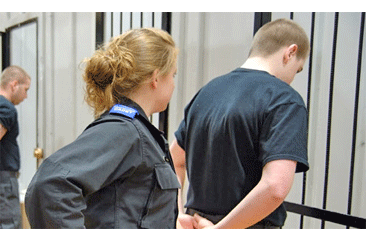|
|
| Recognizing Issues Undercutting the Correctional Workforce |
| By Jessica Herbert |
| Published: 04/08/2013 |
 I have often been shocked when the subject of women in corrections comes up. As a woman who has worked in corrections, I am surprised to hear these discussions peppered with negative terms such as “issues” and “challenges.” And I know that immediately framing the conversations about women in corrections in these terms prevents an accurate understanding of how to handle personnel in the changing culture of corrections.
I have often been shocked when the subject of women in corrections comes up. As a woman who has worked in corrections, I am surprised to hear these discussions peppered with negative terms such as “issues” and “challenges.” And I know that immediately framing the conversations about women in corrections in these terms prevents an accurate understanding of how to handle personnel in the changing culture of corrections.
While preparing to teach a class on women in corrections, I researched why women were interested in such a career—and I discovered that others thought women went into corrections because they wanted to “find a husband,” “fix others,” “take care of people,” etc. These statements were not antiquated thoughts from another era of corrections—they were all made in the last decade. These statements reflect and reinforce misperceptions that permeate the current correctional workforce. These misperceptions compound and underlie the negative framework in our ongoing conversations about women in corrections. Law enforcement and corrections have drastically changed in the last decade, and if they are to continue evolving, those in the workforce must break these misperceptions and remove the negative language. It is time. How? By addressing two key issues that are undercutting the success of the current correctional workforce. The first is that modern correctional workforces are often not structured to welcome and value the work style typically offered by women. A wide variety of research has indicated that women are generally inclined to prefer collaboration, creativity, mentoring, and teamwork in the workplace. However, the current organizational culture of correctional departments and agencies undervalues this kind of contribution. According to Kim Cameron and Robert Quinn’s Organizational Culture Assessment Instrument, there are four major types of organizational cultures:
Other articles by Herbert: Like men, women can streamline processes, increase efficacy, promote teamwork, and improve jobs—and these are qualities needed within correctional departments to meet demands of budgets, increasing populations and regulatory framework. But women are inclined to do so differently, by offering creative and dynamic perspectives built from collaboration and communication. While women’s injection into the workforce should be acknowledged and embraced as an asset, it is instead a problem for a hierarchical culture that is common to many modern correctional facilities. The second issue undermining the success of the current correctional workforce is the misperception that the issues in correctional work are restricted to a single gender. The challenges facing the current correctional workforce aren’t solely due to the addition of women; they are also caused by the addition of newer generations. The current workforce comprises as many as five generations of employees, which makes managing personnel more complex than ever. The newest employees, the so-called Millennials, are particularly dynamic, educated workers. According to a variety of research, these employees prefer collaboration and communication, expect quick promotions and rewards, and want to be listened to by their colleagues and superiors. They aren’t comfortable in a highly formal, structured hierarchy. They are innovative. They are competitive. They are creative. But a hierarchical culture is not. The current issues in the correctional workforce are not exclusively due to women, who are only estimated to comprise 20–35% of the modern correctional workforce (varying by state and department size). Millennials are a new type of employee—and, like women, can be an asset if they are in a culture that can accept their contributions. Every career field must change and evolve to improve and persist over time. Internal and external demands on the correctional workforce are changing, and so we must look at innovative, creative ways to remain competitive and excel. Correctional departments and agencies must be educated on how organizational culture, in addition to the span of generations, impacts the workforce. There will always be offenders serving sentences in a jail or prison—but our facilities and workforces may not always be efficient, staffed by happy personnel, and have plenty of money for operations. Correctional departments must embrace women, especially Millennial women, and the culture of collaboration, innovation, and competition they present. Accepting these new additions to the workforce is key to the progression of the career field and the competitiveness of departments. And it is key to making sure that we in the correctional workforce—with both genders and many generations—are able to meet our metrics and continue serving for generations to come. Corrections.com author, Jessica Herbert, currently works in the private industry. She supports the law enforcement community through education and training as the primary instructor for 3D Professional Training and Consulting and as an adjunct professor for a criminal justice program. She actively mentors women entering and within the workforce for many professions. |
Comments:
Login to let us know what you think
MARKETPLACE search vendors | advanced search

IN CASE YOU MISSED IT
|


Have you been hurt in an accident in Waco Temple or Killeen? Our personal injury lawyers will review your claim to examine if there is enough evidence to support a lawsuit. You may be eligible to file a personal injury claim if you were involved in an accident that was caused by the negligence of someone else. Our Waco bus accident attorneys work with personal injury experts to understand how the accident has changed your life and what money you need to go forward.
Great perception! Ms Herbert, please keep studying this field and writing about it. I mention your article on my blog today: prisongrievances.com